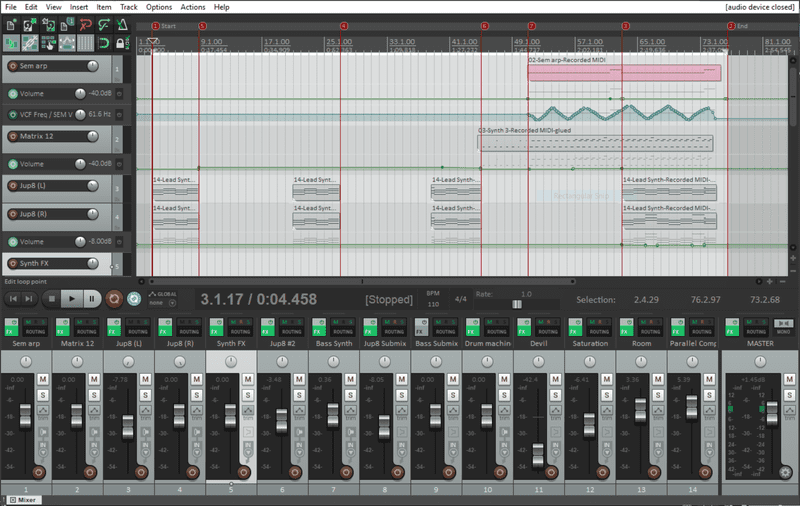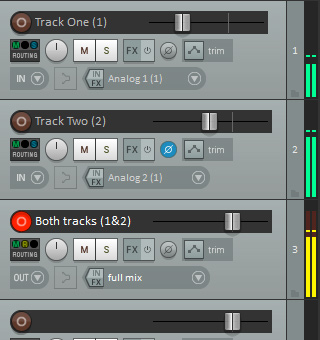How To Conect Audio Interface Onreaper

This guide will explain the necessary steps to get your Focusrite interface set up for recording and playback with Reaper on both Windows and Mac systems. First, you will need to specify which audio device Reaper uses for inputs and outputs. On a Mac, this can be done by going to Reaper Preferences Audio Device. This audio interface works incredibly well with Reaper, which means that you will have access to some of the most powerful software and equipment in the world for your recording needs. Using the USB connection makes it very easy to plug this audio interface into your computer and start recording right away with minimal delay.
How To Connect Audio Interface In Reaper
Rating 4.33 (3 Votes)The M-Track Plus is an all-purpose interface that provides quick and easy setup with a vast number of Digital Audio Workstations. This guide walks through how to configure Reaper with the M-Track Plus properly on your system.Contents.Driver Installation. First, make sure to get the latest driver for your M-Track Plus available. Once the correct and latest driver is downloaded, install the driver.
To do so, locate the installation file after it has downloaded and double click on it to run the program. Follow the prompts on screen to install the driver properly. Once the driver completes the installation click Finish. When the driver installs you will notice there is now an M-Track Plus settings panel in the docking tray at the bottom right hand corner of your desktop.Hardware Setup. Set the input switch on the M-Track Plus to Analog.
Depending on the input channel you are using make sure to turn up the GAIN to an appropriate level. I would recommend starting at 12 o'clock. Set the channel to either MIC/LINE or GUITAR depending on the source you need. Set you MONITOR MIX to USB and finally turn up your Headphone Gain to an appropriate level.Reaper Configuration. Open Reaper and click Options Preferences. Next in the window that opens choose Device under Audio in the list to the left. Make sure that Audio System set to ASIO and set ASIO Driver to M-Track Quad ASIO Driver.
Click the box to Enable Inputs. Once this is done make sure that the Inputs and Outputs are configured as follows and then hit OK:.Now, navigate to Reaper's Mixer in the bottom left hand corner, and select the I/O button. In the window that appears click on Add new hardware output. And choose 1: Analong Output 1 / Analog Output 2.

This is a beginner tutorial on how to do a multi-track recording session. Let us first define multi-track recording:Multi-track recording is a process of recording two or more musical instruments into their respective two or more channels or tracks into a recording device. The recording can be done simultaneously (multi-channel recording) or one at a time.Recording multi-track is very efficient.
It is because it can save a lot of energy in the recording process. Supposing you are the producer that is recording a band with 4 tracks (one vocal, one guitar, one bass, and one percussion); then after the recording; you found out that the guitar solo needs to be change. Without multi-track recording technology, the entire band would need to perform again for the recording.
This is very tedious isn’t it?With multi-track, only the guitarist would need to perform again and the rest of the band would rest. On how to perform multi-track is the subject of this tutorial. This tutorial emphasizes multi-track recording using digital technology. This would let you use your existing PC as a multi-track recording studio. Hardware and Software Requirements of Multi-trackHardware:-A Complete DAW (digital audio recording) system. In digital domain, the recording studio (which is your PC) is your DAW system.
If you are a beginner or don’t have one, you can read this.The heart and soul of your DAW system hardware is the external audio interface. If you are a beginner and on a tight budget, you can read here pertaining to audio interface. Look for one that allows you to record more than 2 tracks with a preamp on each input.
For example; looking into the recommendations on that post; you would most likely select Tascam US-800.Software:The most recommended is.It is a complete multi-track recording solution. Recording One at a time vs. Simultaneous TrackingWhen you are having a multi-track session, the recording can be done in two ways:a.) One at a time– you will be recording musician performance one at a time.b.) Simultaneous tracking– a group of musicians (such as a rock band) would be recorded together/simultaneously.The following are the recommendations:1.) Since recording a drum kit requires different microphones (e.g.
One microphone on snare drum, one on kick drum, etc.) then it should be recorded “simultaneously”.2.) Rock bands whose energy from synergy is important needs also to be tracked simultaneously. Read the details about recording a rock band in the studio.3.) Re-tracking/re-recording/re-take/overdubbing of vocals, bass guitar or guitars in general can be done one at a time. Recording Simultaneously-The General ConceptLet’s start with a slightly more complex procedure of multi-track recording – simultaneous recording sessions.1.) You first need to assign which instruments should occupy each input in your audio interface.2.) You then decide how many tracks you would need to create in your multi-track recording software. As a rule, number of tracks is equal to the number of microphones used. Or it is equal to the number of musical instrument inputs to be recorded together. For example, 6 guitars require 6 tracks to be created.3.) For overall purpose of clarity, make sure you label your tracks in your software so that you won’t get lost.Below is a signal flow of a simultaneous multi-track recording (e.g. You are recording drums).
Reaper multichannel recording setupEnclosed in yellow are your audio interface inputs (Input 1 for the snare, Input 2 for the kick, etc.). You also need to observe proper gain staging as before hitting the record button. Once everything has been set (recording levels, bit depth, sample rate, etc.), hit the record button.Since this is a simultaneous multi-track recording session, there will be four waveforms appearing together and visible on your DAW from Track 1 to Track 4 (if you are recording four tracks). Detailed Multi-track recording example using REAPERFirst, let’s illustrate on how to perform multi-track recording in Reaper with the details. Below are the steps:1.) Go to Insert — Multiple Tracks.
This will let you add several empty tracks for recording at once. Reaper multichannel recording guideAs you can see in the above guide, every musical instrument has its corresponding audio interface analog inputs.
And every analog input of the audio interface has its corresponding REAPER tracks added for recording.3.) Check if you are recording mono. Mono (one channel) is the suggested recording mode for most projects. It is because this corresponds to one instrument to be recorded per track. Refer to some basic guide below:a.) Recording one singer with one microphone is mono in nature.
Audio Interface Wiki
It is because there is only one audio source.b.) Recording one guitar is also mono since there is only one musical instrument.To confirm that you are recording in mono, click the audio interface inputs in your REAPER track. You should see “Input: Mono” checked. See screenshot below.
